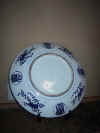





More Antiques......
Above (click to enlarge) are a series of four blue and white plates. Large one on far left (shown top and bottom view on the right) is from Meiji period, 18 inches in diameter. The three other darker blue and white plates are undated, and are common in Meiji, Taisho, and early Showa periods, and contain a 'shochikubai' pattern in the center. Relatively easy to find today. The lighter blue and white plate is unique. This was the dedication gift for the U. S. Naval Hospital in Yokosuka Japan, and is dated 1976. On far right, top and bottom views of a fine, cobalt-blue hand painted plate about 20" in diameter, acquired 11/2000 (Check our the shitake mushrooms for a size comparison on the far right detailed view).
Above: Porcelain Sa'ke containers with brand names in cobalt blue. About 20" high, representing, in porcelain, the straw kegs ('taru') that Sa'ke often comes in. Top contains large cork bonded to porcelain lid, and hole in front is to insert a wooden spigot. I am planning to make into lamp bases. Not difficult to find today. Not expensive.
More Kutani:
Left: Taisho period Kutani Plate "Sparrows in the Snow". Middle: Taisho period cup, highly decorative, calligraphy on inside. Far right: Taisho bowl, from set of three. Click on images to enlarge.
PERHAPS...Kutani? First two images are top/bottom views. Some Kutani and Satsuma characteristics, and I cannot read inscription on bottom. Clearly wartime vintage. On right, unusual plate with opposing rolled rim in Kutani style, but no mark on reverse. Purchased in China for $5, so most likely not a national treasure!
And...Daruma:
Left: a paper Daruma doll face (new). Next: sightless Daruma, waiting for the eye(s) to be painted. Next: a wooden ('kanban') Daruma. Unknown period, unknown artist Daruma ink brush painting with calligraphy. Except for the painting, all Daruma are modern. When you make a wish (set a goal), you buy a sightless Daruma. You paint in the left eye when you are about to attempt your goal, and paint in the right eye upon attaining it. Last three images are 'kokeshi' type wooden Darumas and the trio are actually pencil erasers! Click on images to enlarge.
Misc:
Two carvings of Ebisu, wood, probably early Showa, artist's 'hanko' and inscription on bottom of wooden bases, approximately 6" high. Ebisu is the God of Commerce. Shown with bag of money over his shoulder (L), and a 'Tai" or Sea Bream (R).